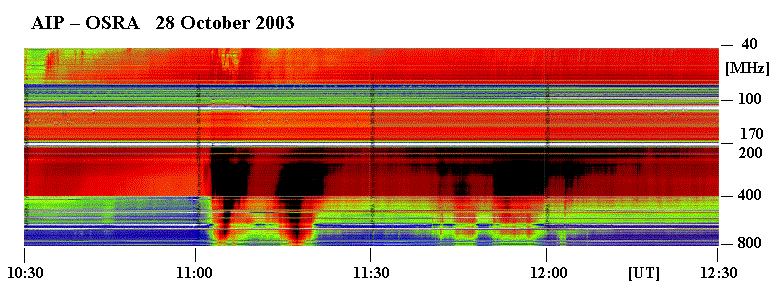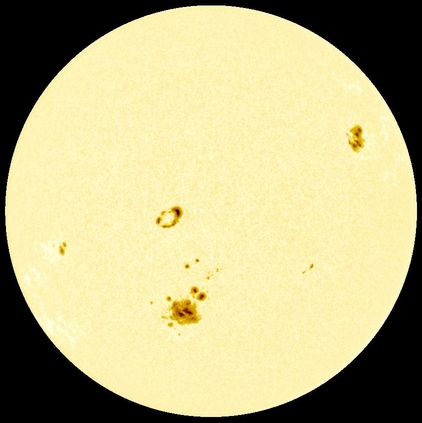|
Huge solar flare disturbes space weather
[deutsch]
Already last week the solar radio observatory of the Astrophysical Institute Potsdam has detected several impressive solar eruptions. An extreme case was observed on October 28, 2003. An X17 flare (very high X-ray importance) occured at S18E20, not far from the central meridian. The responsible active region is visible on the disc image of October 29 shown below.
Flares lead to enhanced emission of electromagnetic waves over a broad spectral range, ejection of high-energy particle streams, and shock waves. Further, they can be associated with coronal mass ejections (CMEs). The CMEs are a larger-scale ejection of a bubble of coronal matter. Both phenomena are typical disturbances of the average solar wind conditions. If such disturbances hit the magnetospheric shield of the Earth we notice a geoeffective change of "Space weather" (indicated by geomagnetic storms, aurorae, enhanced ionospheric absorption etc.).
The radio emission of solar flares (in our spectrum shown between 40 and 800 MHz) comes from the lower corona above the flaring active region. It is the easiest available indicator of the dynamics of nonthermal electrons accelerated during the flare. Further, it reveals the formation and properties of coronal shock waves travelling with average speeds of 700 km/s across the corona and the solar wind. The strength of the radio flux is color coded, black is strongest. Lines parallel to the time axis are terrestrial transmitters (man-made interference). Clearly visible is the broad band covered by USW transmitters between 87 and 108 MHz. The event is superposed to generally enhanced emission. The range between 100 and 170 MHz was disturbed during the event.

2003 October 28
Looking on the propagation direction of the CME main body (see the SOHO link
below; it goes southward), and due to the site of the flaring active region
(Eastern hemisphere) it is not evident that this disturbance will hit the Earth
with its full strength. Especially the flare particle streams will follow the
spiraling field lines of the solar wind field and thus miss the Earth - at least
according to all expectation. But anyway - no rule without exception - it is an
extreme event; may be in a cloudless night we can see auroral effects also in our midlatitudes on October 29/30.
Large sunspot groups populate the visible disk of the Sun. The following image was taken on October 29, 2003, at 09:00 UTC
by the Mees Solar Observatory, University of Hawaii.
At 11:10 UTC on October 28, the strongest ejection was observed from the sunspot group below the middle of the image.

More observations of the event of interest, e.g. from the spacebased ESA/NASA SOHO-Observatory, are available under http://soho.nascom.nasa.gov/hotshots/.
Scientific online spectra
Credits:
H. Aurass
| 

 last change 2005 April 16, R. Arlt
last change 2005 April 16, R. Arlt


